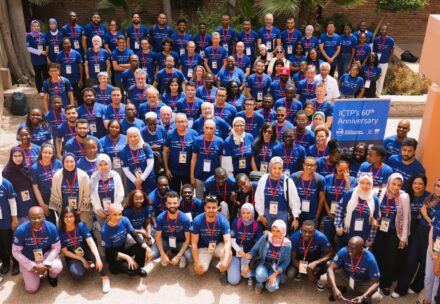The third edition of the school has kicked of swimmingly in Dakar, Senegal (following ASP2010 in South Africa and ASP2012 in Ghana).
This year we have approximately 60 students from all over Africa (plus an Iranian and an American I’m probably forgetting someone) here for three weeks being introduced to everything from the Standard Model of Particle Physics to Cosmology to Particle Detectors to Accelerator physics to Scientific Computing to Medical Physics and much more .
Yesterday I opened the school with a 90 minute general overview of the field to pave the way for the rest of the lectures. The students also had four and a half hours of crash courses on quantum mechanics, relativistic dynamics, Feynman diagrams and cross-sections from a very brave Christoph Englert in order to brush up on material necessary for the rest of the school.
Today I gave them the first half of a three hour introduction to the Standard Model of Particle Physics — where we derived the interactions of the quarks and leptons with gauge bosons starting from the “principles” of gauge symmetry and Lorentz invariance. We finished by deriving the probability that a W-boson will decay into a given lepton/neutrino combination or decay hadronically (via quarks) and compared that to the experimental data. I love this calculation because it agrees remarkably well with the data even though it is approximate. We ended up “eating” into the lunch break by fifteen minutes but I believe it was worth the effort:)
The students (as always) are remarkably perceptive. A young lady from Sudan asked me two excellent questions after my introduction yesterday, which had described some of the evidence that most of the matter in the Universe is dark matter. She asked: how do we really know dark matter exists? She wanted the details! Can dark matter be a Standard Model particle? I’ve had many other excellent questions, but many of the students are particularly fascinated by dark matter as well as the mathematical structure of the Standard Model. Wonderful.
This morning, a very bright young man from Morocco was “unhappy” that he did not have enough homework to do in the evening! I responded today by uploading three exercise sheets on particle physics to keep him and his 59 classmates busy.
Here are the students and some of the lecturers and organisers:
Okay — now I have to finish my next lectures on a) calculating cross-sections
and b) the Higgs boson. I hope to post a couple of updates before I leave on Sunday, but I do have to mention that internet bandwidth and reliability are a real problem in many African countries and Senegal is no exception. I won’t speculate on the causes but it doesn’t take a rocket scientist to figure it out.


